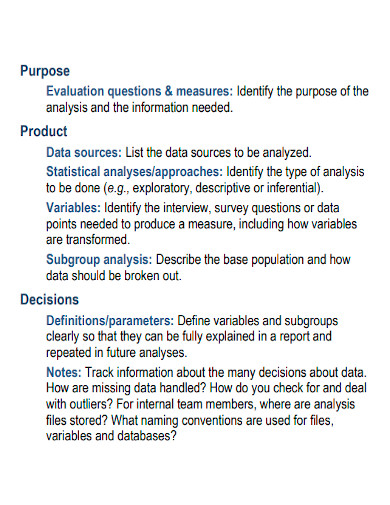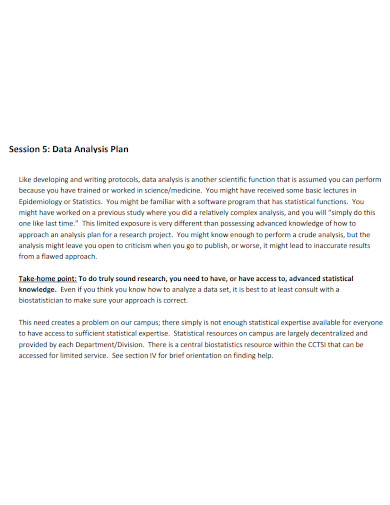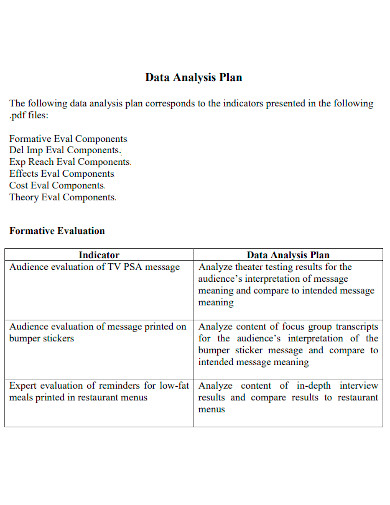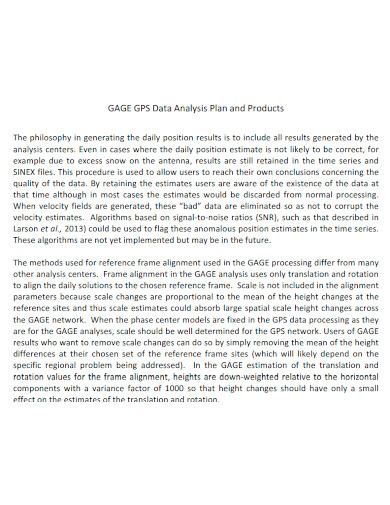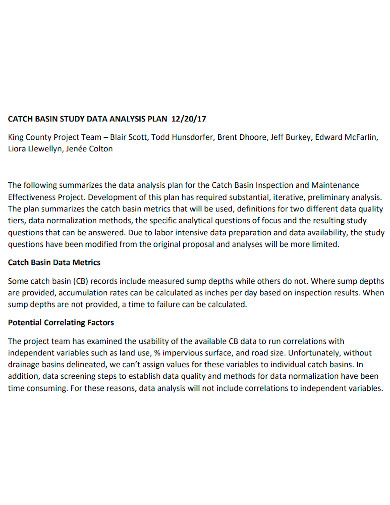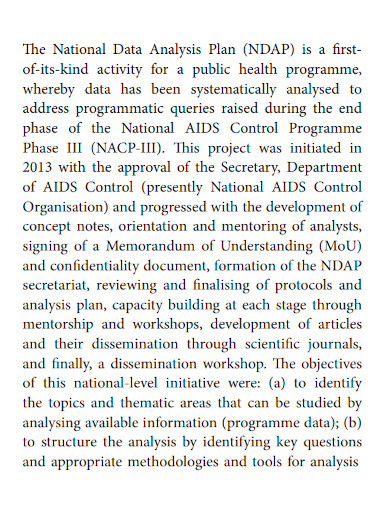When we are tasked to research, we conduct a systematic investigation and gather information or data from all types of possible and relevant resources we can find. Take for instance, business organizations gather data to use for different reasons. This may be to launch a new product, or trying to understand consumer behavior. Government agencies who are trying to initiate a new community project or pharmaceutical companies who are trying to develop the latest drug, and so on. With a data analysis plan, you know what you’re going to do when you actually sit down to do the analysis of the data you’ve gathered. Know more about data analysis in this article, and if you want to get started with your data proposals check out our free data analysis plan samples below:
10+ Data Analysis Plan Samples
1. Data Analysis Plan Sample
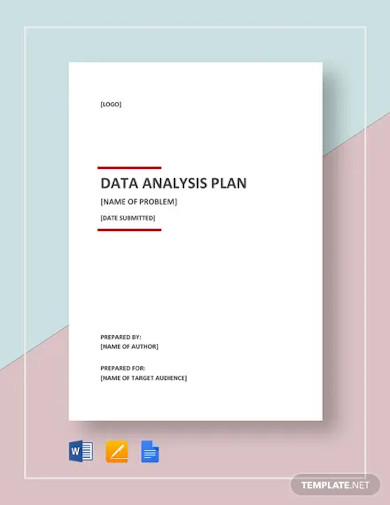
2. Printable Data Analysis Plan
3. Data Analysis Plan Format
4. Standard Data Analysis Plan
5. General Data Analysis Plan
6. Professional Data Analysis Plan
7. Data Analysis Plan and Products
8. Project Data Analysis Plan
9. Report on Data Analysis Plan
10. Data Collection and Analysis Plan
11. Editable Data Analysis Plan
What Is a Data Analysis Plan?
Individuals and organizations has been using data to support their decision-making, create content strategies and or perhaps develop products. Basically, data analysis is the process of collecting and organizing data in order to draw helpful conclusions from it. To be guided on what to do or expect with the data, a data analysis plan is about putting thoughts into a plan of action, an outline for how you’re going to organize and analyze your data. A detailed document outlining procedures for conducting an analysis on data.
How to Write a Data Analysis Plan?
The main purpose of data analysis is to make business decisions that are backed by data. All systematic research is replicable, and to be replicable you need to give the reader the roadmap of how you managed your data and conducted analyses through a data analysis plan. You want to make sure you’ve created your plan beforehand so that you can be sure that you’re asking all the questions you need to and you know what you’re going to do. So where do you start? Here are some components to consider as you draw up your data analysis plan.
I. Purpose
Identify the purpose of the analysis and what information are needed. Such as evaluation or research question(s) and/or hypotheses and measures.
II. Product
- Data Sources: List of data sources or data sets to be analyzed. Determine the general research topic or the questions you need to answer in the analysis. If you are analyzing data in response to a request, determine who needs the answers to the questions, what additional information they need, how often they need the information, and the format in which they need the information.
- Datasets to be used: The size of the dataset or database depends on the number of records and variables.
- Statistical Approaches such as Inclusion Criteria are characteristics that the prospective subjects must have if they are to be included in the study. Exclusion criteria are those characteristics that disqualify prospective subjects from inclusion in the study.
- Variables to be used in the main analysis (the main exposure, outcome, and stratifying variables). Identify the interview, survey questions or data points needed to produce a measure, including how variables are transformed.
- Statistical methods and software to be used
- Subgroup analysis: Characterize the base population and how data should be divided
- Prepare Key Table Shells : When analyzing large datasets, you will conduct three types of analyses: univariable, bivariable, and multivariable data analyses.
III. Decisions
Define variables and subgroups clearly so that they can be fully explained in a report and repeated in future analyses. Also track information about the decisions about data.
IV. Updates
Monitor and take note of the changes made during the analysis process. You can add a notes section in order to document important learnings, progress and information while the rest of the plan gets updated.
V. Results and Outcome
Results and outcome can be incorporated into a plan as data are collected and analyzed. Plans can be used during data meetings and as a framework to facilitate stakeholder collaboration. For discussions consider your audience and use best practices in data visualization and information design.
FAQs
What Is a Descriptive Analysis?
Descriptive Analysis is one of the most important steps for conducting statistical data analysis. As this is type of analysis of data that helps describe, show or summarize data points in a constructive way such that patterns might emerge that fulfill every condition of the data.
What Is a Quantitative Data Analysis?
A quantitative data analysis is a type of analysis that deals with number based data. Quantitative analysis includes computational and statistical methods of analysis.
What Is Data Collection?
Data Collection is the method of gathering and measuring information from a variety of sources to get a complete and accurate picture of an area of interest.
The relevance of a data analysis plan in any area of interest provides direction and arrangement on how to go about the data analysis process. With this important data could be identified early on, you are able choose the correct statistical tools, analyze the collected data and then present the interpreted data in results. Making it an easier process for individuals or organizations to go about analyzing data that could be use to their benefit.
Related Posts
FREE 9+ 30-Day Marketing Plan Samples in PDF | MS Word | Apple Pages | Google Docs
FREE 3+ Sales Team Action Plan Samples in PDF | MS Word | Apple Pages | Google Docs
Marketing Plan For Small Business Samples
FREE 7+ Fashion Business Plan Samples in PDF
FREE 10+ Sprint Planning Samples In MS Word | Google Docs | PDF
FREE 10+ Wedding Planning Samples in MS Word | Apple Pages | Powerpoint | PDF
FREE 9+ Monthly Study Planner Samples in PSD | Illustrator | InDesign | PDF
FREE 9+ Sample Curriculum Planning Templates in PDF | MS Word
FREE 10+ Teacher Development Plan Samples in MS Word | Google Docs | Apple Pages | PDF
FREE 10+ Basketball Practice Plan Samples in PDF
FREE 12+ School Business Plan Samples in PDF | MS Word | Apple Pages | Google Docs
FREE 7+ Client Strategic Plan Samples in PDF | MS Word
FREE 11+ Trucking Business Plan Templates in PDF | MS Word | Google Docs | Pages
FREE 7+ Small Hotel Business Plan Samples PDF | MS Word | Apple Pages | Google Docs
FREE 14+ Bakery Business Plans in MS Word | PDF | Google Docs | Pages

